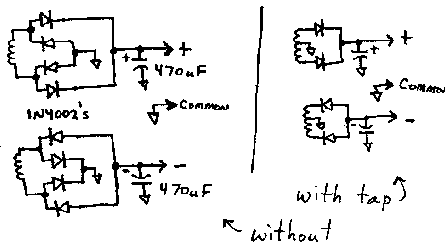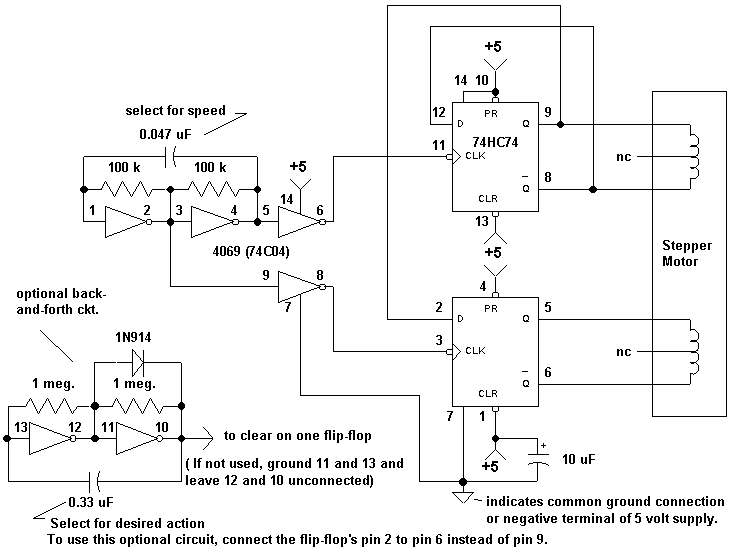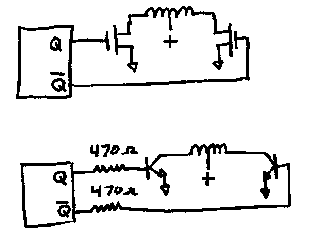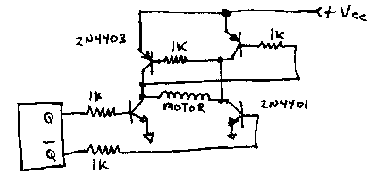

Stepper motors are most commonly controlled by microprocessors or custom controller ICs and the current is often switched by stepper motor driver ICs or power transistors. Precise motion is possible but the complexity usually lands the hobbyist's stepper motors in the "maybe someday" parts bin. But steppers may be used for a variety of applications without complex circuitry or programming. At first glance the stepper motor looks a bit intimidating since there are at least four wires and often there are six. Most steppers have two independent windings and some are center-tapped, hence the four or six wires. A quick ohmmeter check will determine which wires belong together and the center-tap may be identified by measuring the resistance between the wires; the center-tap will measure 1/2 the total winding resistance to either end of the coil. Tie the wires that belong together in a knot and tie another knot in the center-tap wire for easy identification later. Stepper motors have become quite abundant and are available in all shapes and sizes from many surplus dealers. Experimenters can also salvage excellent steppers from old office and computer equipment.
Steppers move in small increments usually indicated on the label in degrees. To make a stepper motor spin in one direction current is passed through one winding, then the other, then through the first winding with the opposite polarity, then the second with flipped polarity, too. This sequence is repeated for continuous rotation. The direction of rotation depends upon which winding is the "leader" and which is the "follower". The rotation will reverse if either winding is reversed. The center-tapped versions simplify the reversal of current since the center-tap may be tied to Vcc and each end of the coil may be alternately pulled to ground. Non-tapped motors require a bipolar drive voltage or a bit more switching circuitry. If current is applied to both windings, the stepper will settle between two steps (this is often called a "half-step"). Taking the half-step idea to the extreme, one could apply two quadrature sinewaves to the windings and get very smooth rotation. This technique would not be particularly efficient since the controller would be dissipating at least as much power as the motor but, if smooth motion is required, it might be worth a try! Or, for those who don't mind complexity, the sinewaves could be efficiently approximated by using variable duty-cycle pulses. But the purpose here is to get those motors out of the junk box, not to think of more reasons to leave them alone! So here are some simple things to try.
Steppers make excellent low power generators and surprisingly efficient low power motors for low RPM applications. As a starting point, try connecting the windings of two steppers together. Pick steppers that turn freely so that internal friction doesn't spoil the experiment. When you spin one motor shaft, the other will follow. Admittedly, there is little torque. But it does illustrate that steppers may be used to generate electricity. Here are a couple of sketches showing how to connect stepper motors as generators:

The AC windings are not directly connected since the voltages are 90 degrees out of phase and the resulting voltage would be somewhat lower. Dual isolated outputs are possible if the grounds for each winding are not connected together. Here are a few application ideas:
| Add a hand crank and bulb for kids' science demonstration. A 24 volt stepper will light a 120 volt nightlight or Christmas tree light. | |
| Make a wind-powered anemometer. | |
| Generate a higher voltage by turning a high voltage stepper with a low voltage motor. | |
| Run various gadgets including radios, calculators, multimeters, flashers, garage door openers, remote controls, LED flashlights, bike flashers. | |
| Achieve extreme isolation - use a long plastic shaft to turn the generator for high voltage isolation or use a line-powered motor to spin a stepper for very high line isolation. |
A large capacitor may be charged to run low current devices for some time after a few quick spins of the crank. A voltage regulator may be required for some devices but use an efficient series regulator to conserve power if the affair is hand-powered.
Many steppers make excellent low power motors despite the markings on the label. For example, a stepper rated at 16.8 volts, 280 mA consumed only 20 mA when unloaded and driven with bipolar 5 volt squarewaves. Such low currents may be directly extracted from many op-amps and logic devices without any additional drivers! Obviously the mechanical load must be light and the speed will be low or the motor will stall but many useful applications exhibit little load. Here are some examples:
| Use vanes to mechanically chop light, electrostatic fields or other radiation. | |
| Spin a sign or attention-getting symbol on an advertising display. | |
| Spin a toy radar antenna or make a highly efficient electric toy car or train. | |
| Make a spinning Christmas tree ornament. | |
| Make a laborator stirrer. |
The following circuit is commonly called a quadrature oscillator or a sine - cosine oscillator and may be built using almost any op-amp with reasonably high output current. An LM358 actually worked in this circuit, but only barely! A better choice would be an LM833 or any one of many higher current op-amps.

The two transistors generate Vcc/2 so that the current in the windings will reverse when the op-amps go high and low. They are not needed if a dual polarity power supply is used. Simply ground the windings that go to the emitters. A motor rated at 16.8 volts and 280 mA consumed only 30mA in the above circuit when unloaded. Try whatever stepper motor is available and adjust the power supply voltage for proper operation. Don't expect to get much torque from this circuit! For more drive capability connect two transistors to the op-amp outputs in the same manner as the Vcc/2 circuit above. Leave out the resistors and simply connect the two bases to the op-amp output. The two emitters connect together and to the motor winding.
The above circuit is all that is needed for many applications but the following circuit has a bit more flexibility.

In this circuit the 74HC74 directly drives the stepper motor for low power applications. The two flip-flops are alternately clocked to give the desired "follow-the-leader" pulse train. The 16.8 volt motor (1.8 degree step size) described above draws only 20 mA in this circuit and a tiny 15 degree step size, 12 volt motor only draws 30 mA. The unused inverters are wired to form a slow pulse generator which may be used to randomly change the direction of rotation. Actually, the change of direction will often synchronize with the spin oscillator giving a back-and-forth action unless the oscillator frequency is just right. This change of direction will add interest to moving displays.
The circuit generates four control signals and adding circuitry for high power operation is fairly easy. If a center-tapped motor is used then the following connection will work:

You will need one of these circuits for each motor winding. If the motor doesn't have a center-tap then try the circuit below. The values are only representative and may vary depending upon the motor and transistor gain. No provisions are shown to protect against inductive kickback but small motors don't seem to generate much. However, some care may be required if larger motors and higher currents are used. Consider adding diodes from each motor winding to Vcc (the cathode goes to Vcc). Also, the 2N440Xs are only good for a few hundred milliamps so choose heftier transistors and use lower value resistors if higher motor currents are expected.

The flip-flop shown is an HC device and its power supply should be limited to 5 or 6 volts but the flip-flop could be a 4000 series device if driver transistors are added. The 4000 series devices cannot supply much current but they will run on +15 volts. Increase the resistors to 10k and use darlington transistors (or mosfets such as the VN10KM) in place of the NPNs shown.
![]()
|
Here is a note sent in by Garin : I appreciate your experimenters internet home site for new electronics nuts. A good source of a ready made "robot" stepper motor system is an old dot matrix computer printer. Not only does it contain several motors, but it also has in it the electronics to drive them which can be interfaced to your control computer via the parallel port. Old manuals list control codes which can be translated into your application much faster and cheaper than designing your own system. In fact with the advent of color inkjet printers, many old dot matrix PC computer printer can be had for free. Hopefully this note will be of help. |